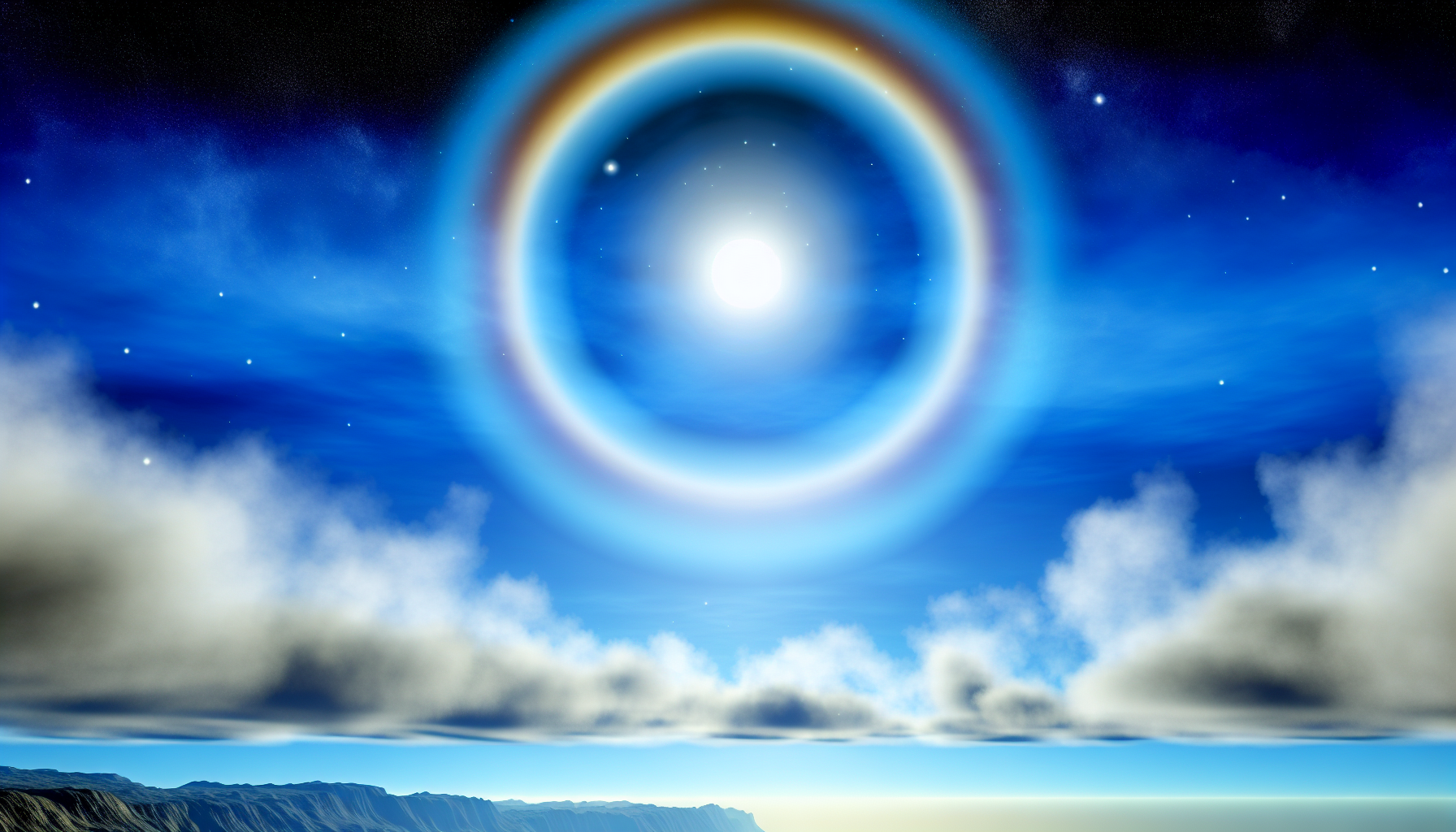The halo around the sun biblical meaning is a topic that intrigues and delights many, from scholars and theologians to faithful observers around the globe. Often appearing as a luminous ring surrounding the sun, this optical phenomenon, known scientifically as a ’22-degree halo’, captivates the imagination and stirs spiritual reflection. Is it merely a meteorological effect, or does it hold deeper biblical significance? This exploration delves into historical interpretations, biblical references, and the symbolic meanings ascribed to this celestial spectacle.
The Scientific Explanation
Before delving into its biblical interpretations, understanding the scientific foundation of the sun’s halo is crucial. This phenomenon occurs due to the refraction, reflection, and dispersion of light through ice crystals suspended in the atmosphere. Typically, these ice crystals are found in cirrus clouds at high altitudes. When light passes through the hexagonal ice crystals, it bends at a 22-degree angle, creating a circle around the sun.
Despite its scientific explanation, the appearance of a halo around the sun has often been perceived as an omen or a sign from the divine across various cultures and religions. In the context of Christianity, such natural occurrences are sometimes considered in a religious light, prompting believers and scholars to seek a deeper understanding within the scriptures.
Biblical Symbols and Their Interpretations
In the Bible, light has always been a symbol of God’s presence and purity. The halo phenomenon can be likened to several Biblical passages where light, brightness, and circles represent divine glory and protection. For example, the book of Psalms frequently mentions God’s light as guidance, “The LORD is my light and my salvation; whom shall I fear?” (Psalm 27:1).
Moreover, circles are often symbolic of eternity and perfection in biblical literature, seen in the descriptions of visions like that of Ezekiel, where he describes an “expanse, sparkling like ice, and awesome” that stretched over the heads of the creatures representing the glory of God (Ezekiel 1:22). Such imagery could be interpreted as having similarities to a halo around the sun, suggesting a visual manifestation of divine glory.
Cultural and Historical Context
Throughout history, the appearance of a halo around the sun has been noted and revered in many cultures. In Christian art, halos have been used extensively to denote holiness and divine connection. Saints, angels, and Jesus Christ are often depicted with a light or a halo around their heads, symbolizing their sanctity and closeness to divinity.
The Christian tradition is not unique in its reverence for solar halos. For instance, Native American folklore and various Eastern religions also interpret the ring around the sun with great spiritual significance, often seeing it as a harbinger of change or a sign from the gods.

In medieval times, a halo around the sun prompted a variety of reactions—fear, awe, and interpretation as a celestial sign. Given the lack of scientific understanding at the time, these interpretations were deeply imbued with religious and cultural significance, influencing decisions from agriculture to warfare.
Theological Perspectives and Modern Interpretations
While many early interpretations of sun halos were rooted in fear or seen as divine interventions, modern Christian theologians often view these phenomena through a lens of wonder and a reminder of God’s creation. This shift aligns with a broader movement in Christianity towards interpreting natural occurrences as reasons to reflect on and appreciate the divine creation rather than as messages or omens.
In contemporary discussions, theologians like John Piper and Timothy Keller discuss the beauty of natural phenomena as “theaters of God’s glory,” suggesting that events like a halo around the sun, while natural, also provide an opportunity for humans to witness the magnificence and precision of God’s creation.
Practical Implications in Faith
Considering the halo around the sun in a practical faith context can lead to rich spiritual reflections. For the believer, such phenomena can serve as moments to pause, reflect, and acknowledge God’s presence in the natural world. They can be seen as invitations to appreciate the intricate beauty of creation and to meditate on the light of Christ that guides and protects.
Furthermore, these moments can be powerful in communal and liturgical settings. For instance, during times when a solar halo appears, communities can gather to reflect on spiritual themes of light, guidance, and protection, incorporating these themes into prayers and hymns.
Reflections in Contemporary Culture
In today’s digital age, images of sun halos quickly spread across social media platforms, often accompanied by expressions of awe and spiritual wonder. This ubiquity has allowed a resurgence of interest in their symbolic meanings. For many, sharing a photo of a sun halo becomes a means of conveying hope and beauty, elements that are deeply rooted in the scriptural interpretations of such signs.
This cultural moment offers an opportunity for Christian leaders and educators to engage with the public. They can provide insights into the theological implications of natural phenomena, bridging ancient scriptural interpretations with contemporary spiritual life.
Conclusion
The halo around the sun holds a place both in the physical realm of meteorological science and in the spiritual domain of biblical symbolism. While understood today through the lens of atmospheric optics, its occurrence continues to inspire a sense of wonder and divine presence among many. This blending of natural explanation with spiritual meaning enriches the faith experiences of believers, offering a multifaceted perspective that ties the mysteries of the natural world with the mysteries of the divine.
At its core, whether seen through the eyes of science or scripture, the halo around the sun reminds us of the intricate beauty of the universe and the continuous presence of the divine in everyday phenomena.
FAQs
1. What exactly causes a halo around the sun?
A halo around the sun is caused by the refraction, reflection, and dispersion of light through ice crystals in the atmosphere, typically found in cirrus clouds.
2. Are there any specific Bible verses that mention a halo around the sun?
The Bible does not explicitly mention a halo around the sun, but there are many references to celestial signs, light, and brightness that can be symbolically linked to such phenomena.
3. How often do sun halos occur?
Sun halos are fairly common atmospheric phenomena but depend largely on the presence of cirrus clouds and specific atmospheric conditions.
4. Can a halo around the sun be seen everywhere in the world?
Yes, sun halos can be seen worldwide, provided the atmospheric conditions are right, regardless of geographic location.
5. How should Christians interpret the appearance of a sun halo?
While interpretations can vary, many Christians view sun halos as a reminder of God’s creation and glory, meant to inspire awe and reflection on divine presence.



